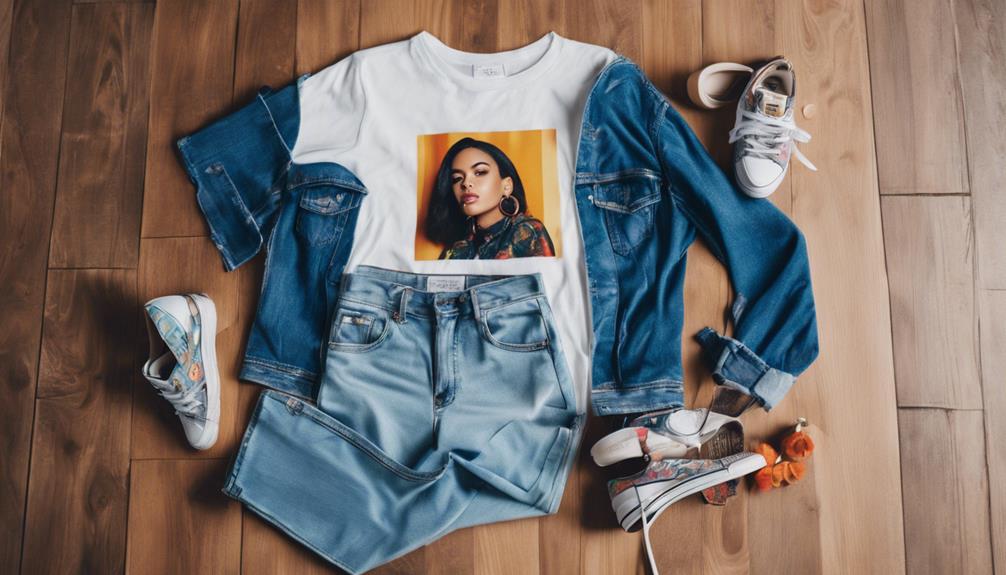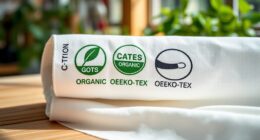Fast fashion greatly impacts the environment, accounting for about 10% of global carbon emissions and generating 92 million tons of textile waste annually. Its reliance on synthetic materials and rapid production leads to substantial water waste and pollution. In contrast, slow fashion prioritizes quality and sustainability through eco-friendly materials and ethical production practices. This approach reduces waste, encourages mindful consumption, and fosters a healthier planet. By choosing slow fashion, you support fair labor and promote durability in garments. If you explore further, you'll discover how these choices can reshape the fashion industry sustainably.
Key Takeaways
- Fast fashion significantly contributes to global carbon emissions, accounting for about 10%, projected to rise to 26% by 2050.
- The fast fashion industry generates 92 million tons of textile waste annually, with 85% ending up in landfills.
- Slow fashion promotes sustainable practices, utilizing eco-friendly materials and emphasizing quality to reduce waste and encourage responsible consumption.
- Ethical concerns in fast fashion include unsafe working conditions and child labor, impacting millions of workers in developing countries.
- Supporting slow fashion brands fosters a culture of mindful consumption and promotes fair wages and sustainable practices in the fashion industry.
Understanding Fast Fashion
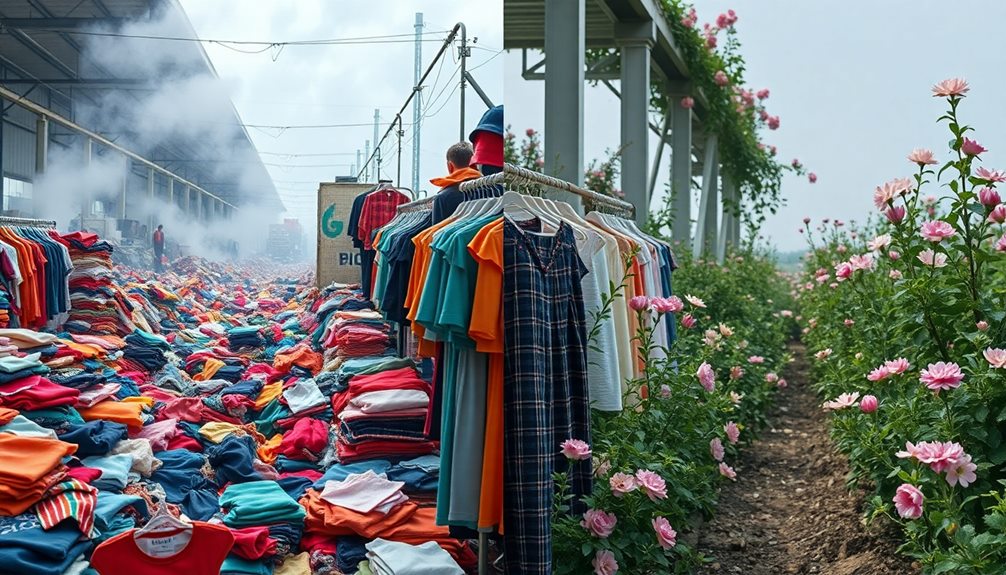
Fast fashion, with its rapid production cycles and trend-driven designs, has reshaped the way you shop for clothes. This industry thrives on low prices, allowing you to buy new items frequently, often without considering the environmental impact. Brands like Zara, UNIQLO, and H&M have popularized this model since the early 1990s, emphasizing high volume over sustainable practices.
Fast fashion relies heavily on synthetic materials, such as polyester, which are derived from petroleum. This reliance leads to significant resource consumption; for example, producing a single T-shirt requires about 2,700 liters of water.
With such demands, the clothing industry contributes to a throwaway culture, where garments are often discarded after just a few wears. This cycle of rapid production results in approximately 92 million tons of textiles being discarded each year, exacerbating environmental issues.
Additionally, fast fashion accounts for around 10% of global carbon emissions. As you navigate this landscape, it’s essential to recognize the consequences of your choices and consider the long-term effects of supporting fast fashion over more sustainable alternatives. Moreover, the impact of fast fashion extends beyond carbon emissions, contributing to vast amounts of waste and the exploitation of labor in developing countries. As consumers increasingly prioritize sustainability, trends such as the ‘gorpcore fashion trend explained‘ have emerged, emphasizing functionality and eco-consciousness in clothing choices. By opting for more sustainable styles, individuals can align their wardrobes with their values, ultimately helping to reduce the negative impact that textiles have on the environment.
Environmental Effects of Fast Fashion
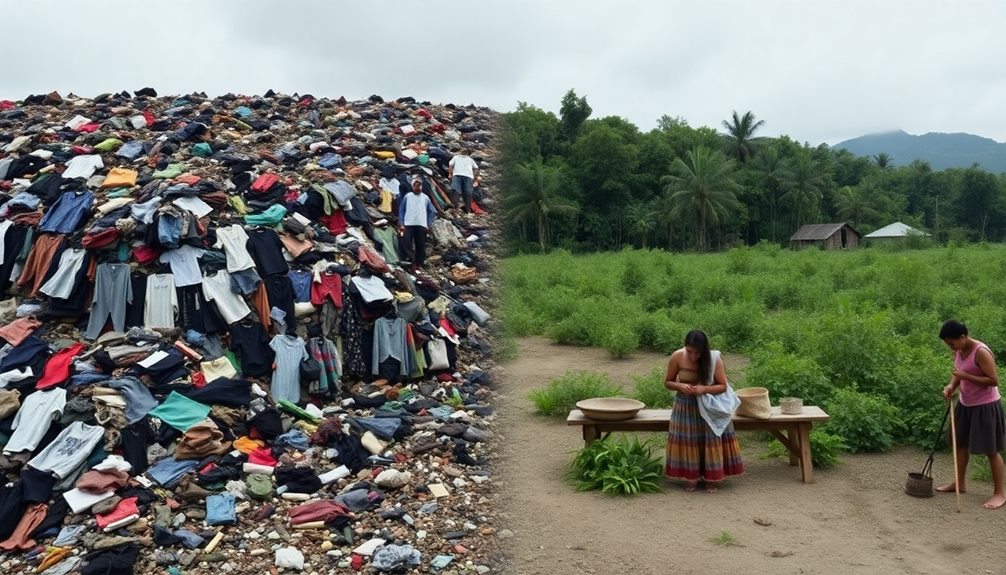
The environmental effects of fast fashion can't be ignored, as this industry considerably impacts our planet. Fast fashion is responsible for about 10% of global carbon emissions, a figure projected to rise to 26% by 2050 if current practices continue.
With the relentless consumption of cheap clothing, it generates approximately 92 million tons of textile waste annually, where 85% of textiles end up in landfills.
Moreover, fast fashion's production processes contribute to 20% of global industrial wastewater pollution, severely affecting water resources and ecosystems. It's estimated that this industry consumes around 215 trillion liters of water each year—enough to fill 86 million Olympic-sized swimming pools—exacerbating water scarcity issues.
Additionally, washing synthetic garments releases roughly 500,000 tons of microfibers into the oceans annually, leading to marine pollution that harms marine life.
These environmental impacts highlight the urgent need for sustainable fashion and slow fashion alternatives, emphasizing ethical production practices that minimize harm to our planet.
Ethical Concerns in Fast Fashion
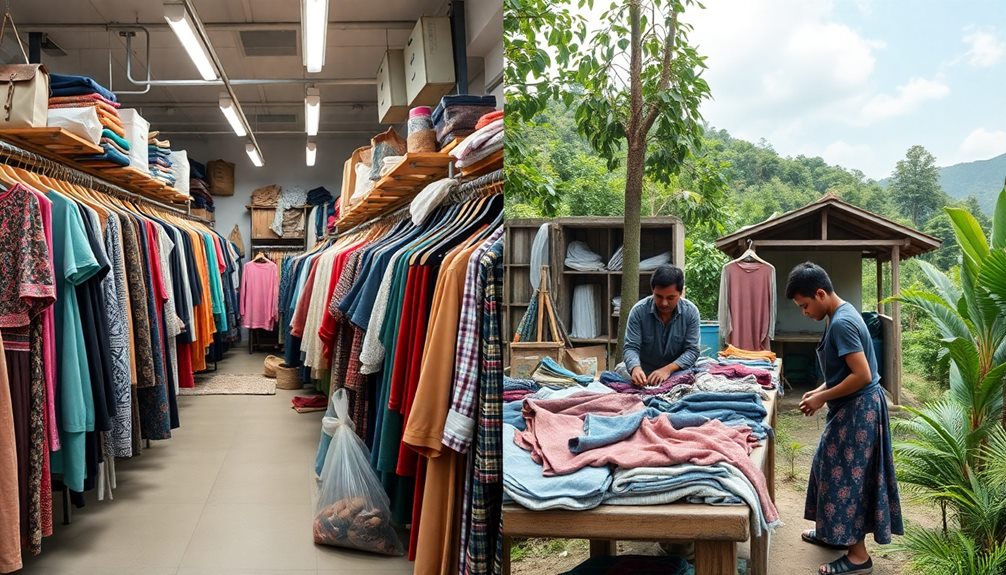
While environmental impacts are a pressing concern, ethical issues in fast fashion demand equal attention. The industry often relies on exploitative labor practices, where about 80% of apparel is produced by young women aged 18-24 in developing countries. These workers frequently endure unsafe working conditions and receive low wages that don't reflect their efforts.
The tragic Rana Plaza factory collapse in 2013, which killed over 1,100 workers, starkly illustrated the dangers tied to fast fashion's relentless pursuit of cheap labor.
Additionally, over 250 million children are involved in the global textile industry, many toiling under conditions that violate child labor laws. In countries with weak labor regulations, workers face long hours in hazardous environments, leading to significant human rights violations.
This reliance on cheap labor perpetuates a cycle of poverty, undermining the economic stability of local communities without offering adequate protections.
Sustainable fashion brands aim to break this cycle by promoting ethical practices and prioritizing fair wages and safe working conditions.
As you consider your clothing choices, remember that supporting sustainable brands can help combat the ethical concerns surrounding fast fashion and contribute to a more just production process.
Principles of Sustainable Fashion
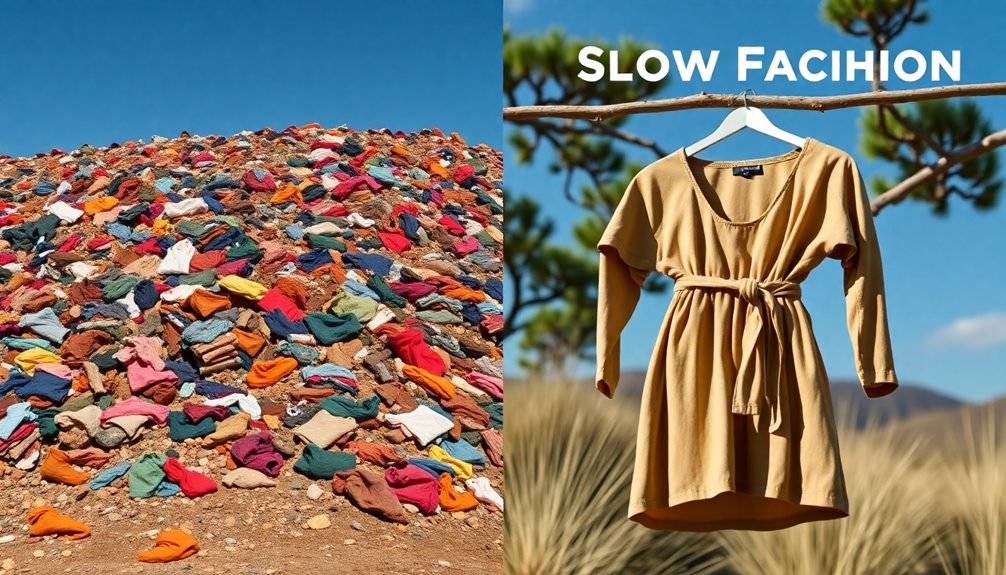
When you think about sustainable fashion, consider how it champions ethical production practices that guarantee fair wages and safe working conditions for workers.
It also emphasizes the use of eco-friendly materials, like organic cotton and recycled fibers, which help reduce environmental harm.
Plus, by focusing on the entire lifecycle of garments, sustainable fashion encourages thoughtful consumption and minimizes waste.
Ethical Production Practices
Sustainable fashion's commitment to ethical production practices fundamentally shifts how we think about clothing. Unlike the fast fashion industry, which often exploits workers and prioritizes profit over people, sustainable fashion guarantees fair wages and safe working conditions. This approach addresses the severe issues of exploitation within the industry, fostering a more humane and equitable production environment.
Furthermore, the principles of emotional alignment can also apply to consumer choices, encouraging individuals to select brands that resonate with their values.
By emphasizing transparency and traceability within the supply chain, sustainable fashion allows you to make informed choices about your clothing. You can feel confident knowing that your garments are produced ethically, with a focus on high-quality materials and processes. This commitment not only enhances the durability of your clothing but also helps reduce waste by encouraging long-term use—something that counteracts the throwaway culture prevalent in fast fashion.
Additionally, ethical production practices often incorporate eco-friendly materials, which considerably diminish the environmental impact of textile production. By supporting brands that prioritize these values, you contribute to a system that minimizes pollution and conserves resources.
Ultimately, embracing ethical production practices in sustainable fashion leads to a more responsible and conscious way of consuming clothing, benefiting both people and the planet.
Eco-Friendly Materials Usage
The commitment to ethical production practices naturally extends to the materials used in sustainable fashion. By choosing eco-friendly materials, you can greatly reduce the environmental impact of your wardrobe.
For instance, organic cotton requires 91% less water than conventional cotton, promoting water conservation and minimizing strain on freshwater resources. Another excellent option is Tencel, made from sustainably sourced wood pulp. This biodegradable fiber is produced in a closed-loop process that recycles water and solvents, drastically cutting down on textile waste and pollution.
Recycled polyester is another smart choice, saving up to 60% of the energy needed to create virgin polyester, which in turn lowers carbon emissions and reduces reliance on fossil fuels.
By opting for these sustainable practices, you not only contribute to a healthier planet but also help divert textile waste from landfills, as many of these options are designed to be biodegradable or recyclable at the end of their lifecycle.
Embracing eco-friendly materials is an essential step toward revealing the full potential of sustainable fashion and creating a greener future for the industry.
Lifecycle of Garments
In the journey of fashion, understanding the lifecycle of garments is vital for making informed choices. Sustainable fashion emphasizes designing for durability and recyclability, which minimizes waste and resource consumption. By opting for eco-friendly materials like organic cotton and recycled fibers, you'll considerably reduce the environmental impact associated with garment production.
Unfortunately, the average garment is worn just seven times before being discarded in fast fashion. In contrast, sustainable fashion promotes quality craftsmanship and timeless designs to extend clothing's lifespan. This approach not only benefits your wardrobe but also contributes to a circular economy, where garments are reused, repaired, or recycled.
By embracing this lifecycle of garments, you can help combat the staggering 92 million tons of textile waste generated annually. A full lifecycle approach considers the environmental and social impacts throughout the supply chain, from raw material sourcing to end-of-life disposal.
When you make conscious choices about the clothing you buy and how you care for it, you're playing a vital role in reducing textile waste and fostering sustainable practices in the fashion industry.
Together, we can create a more responsible and eco-friendly future.
The Impact of Slow Fashion

When you choose slow fashion, you're opting for garments made from eco-friendly and recycled materials that greatly cut down on environmental harm.
By investing in high-quality pieces, you help reduce waste and lessen the need for constant replacements.
This conscious approach not only benefits the planet but also supports a more sustainable fashion industry.
Eco-Friendly Materials Usage
Embracing eco-friendly materials is a cornerstone of slow fashion, offering a sustainable alternative to the harmful practices of fast fashion. By choosing materials like organic cotton, Tencel, and recycled fabrics, you considerably reduce the environmental impact associated with conventional textiles. For instance, organic cotton uses 91% less water than traditional cotton, making it a sustainable choice for garment manufacturing.
Slow fashion brands often prioritize natural dyes and non-toxic chemicals, which contribute to reducing water pollution—an alarming issue, as the fashion industry accounts for 20% of global industrial wastewater pollution. By focusing on durable, high-quality materials, slow fashion encourages a culture of waste reduction, as these garments are designed to last longer. This counters the throwaway mentality propagated by fast fashion.
Moreover, adopting closed-loop systems in slow fashion allows for the recycling of materials, minimizing the demand for new resources and further reducing your overall environmental footprint.
| Material Type | Benefits |
|---|---|
| Organic Cotton | Uses 91% less water |
| Natural Dyes | Reduces water pollution |
| Recycled Fabrics | Supports waste reduction |
Waste Reduction Strategies
Slow fashion offers practical waste reduction strategies that directly combat the negative impacts of overconsumption. By focusing on high-quality, long-lasting products, you reduce the need for frequent replacements, which greatly minimizes textile waste. This approach emphasizes responsible consumption, encouraging you to invest in sustainable garments that last longer and perform better.
Utilizing eco-friendly and recycled materials further decreases the environmental impact of garment production. Choosing pieces made from these materials means supporting practices that help preserve our planet's resources.
The concept of a capsule wardrobe is another effective strategy, promoting versatility in your clothing choices. By selecting a few key pieces that mix and match, you'll find that you can create numerous outfits without constantly buying new items.
Additionally, embracing second-hand clothing is a powerful way to divert textiles from landfills. This not only prolongs the life of garments but also reduces the demand for new production.
Consumer Choices and Slow Fashion

How can your choices influence the fashion industry? By embracing slow fashion, you can greatly impact its environmental footprint. Opting for high-quality, durable garments means fewer items in landfills, helping to reduce the staggering 82 pounds of textile waste generated per American each year. Supporting ethical brands that prioritize sustainable practices promotes fair labor conditions and environmentally responsible production methods.
Additionally, prioritizing balanced nutrition in your lifestyle can enhance your overall well-being, making you more conscious of your consumption habits.
When you choose to replace fast fashion items with second-hand or slow fashion alternatives, you actively decrease the demand for new products, which lowers the industry's carbon footprint. Mindful consumption is key; by building a capsule wardrobe filled with versatile pieces, you can encourage smarter purchasing habits. This approach not only helps you prioritize quality over quantity but also fosters a sustainable mindset in your fashion choices.
Your consumer choices shape the industry. Each purchase sends a message—when you choose slow fashion, you advocate for a more responsible and ethical approach to clothing. By prioritizing durable garments and supporting brands committed to sustainability, you're contributing to a positive shift in fashion that benefits both people and the planet.
Differences Between Fast and Slow Fashion
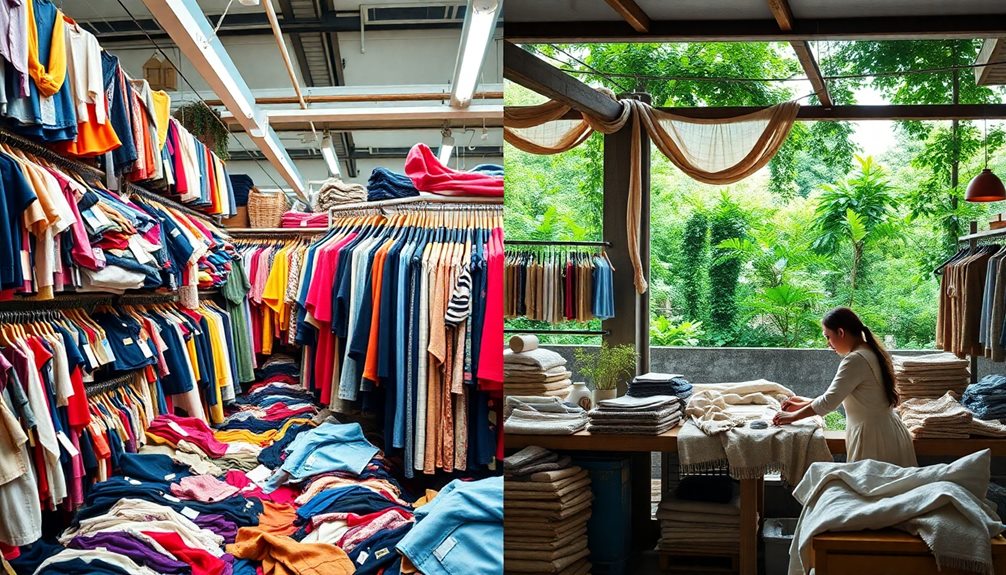
The fashion landscape today reveals stark contrasts between fast fashion and slow fashion, each representing different values and practices. Fast fashion thrives on rapid production and low-cost garments, fostering a throwaway culture that leads to the staggering creation of 80 billion new clothing items each year.
In contrast, slow fashion emphasizes high-quality, durable pieces that promote responsible consumption and longevity.
When you consider the environmental impact, fast fashion is responsible for 10% of global carbon emissions, a figure expected to rise. Slow fashion counters this by utilizing sustainable resources and energy-efficient production methods to minimize harm.
Furthermore, fast fashion's reliance on synthetic materials notably contributes to ocean microplastics, while slow fashion prioritizes natural materials, reducing ecological damage.
Ethical labor practices also set these two movements apart. Fast fashion often subjects workers to poor conditions and low wages, whereas slow fashion champions fair labor and safe environments.
Benefits of Supporting Slow Fashion

By choosing to support slow fashion, you're making a significant impact on the environment and the industry as a whole. When you invest in slow fashion, you help reduce textile waste, which amounts to a staggering 92 million tons discarded annually due to fast fashion.
Slow fashion prioritizes durable garments that last, promoting quality over quantity. This approach aligns with sustainable agriculture practices that emphasize the importance of eco-friendly production methods. Furthermore, supporting slow fashion means advocating for eco-friendly materials and sustainable production processes. This choice minimizes the 20% of global industrial wastewater pollution attributed to the fashion industry. By doing so, you're contributing to a healthier planet.
Another crucial benefit is the shift towards ethical labor practices. By choosing brands that embrace slow fashion, you're standing up for the over 250 million workers in the textile industry who deserve fair wages and safe working conditions.
Your choices help foster a culture of mindful consumption, encouraging you and others to buy less but appreciate more.
Future of Fashion Sustainability
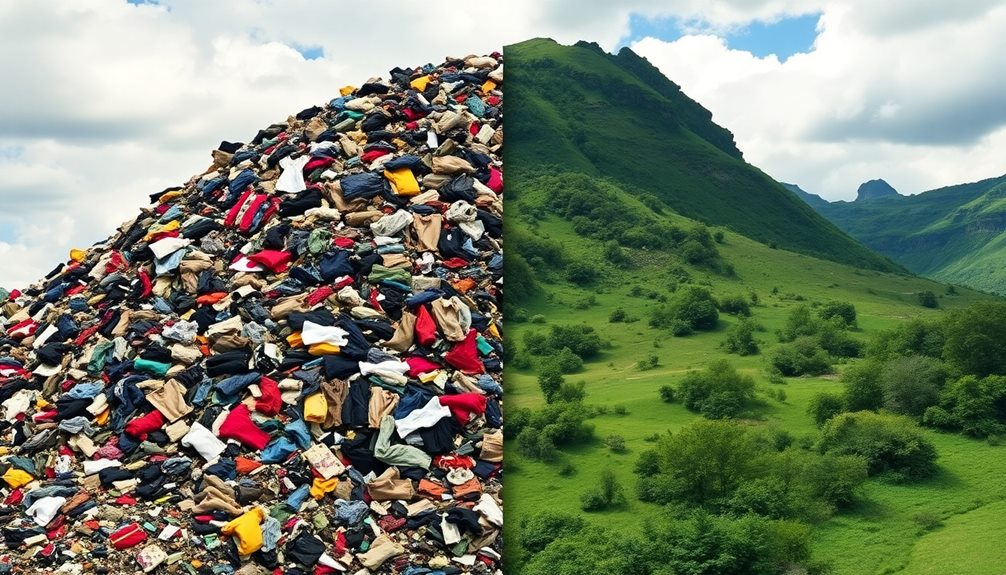
Fashion's future hinges on sustainability, with a growing consensus that the industry must change its ways to survive. If current unsustainable practices persist, the global fashion industry could see carbon emissions soar from 2-8% to as much as 26% by 2050.
To combat this, initiatives like the Fashion Industry Charter for Climate Change aim for net-zero emissions by that same year. You can contribute to this effort by supporting sustainable brands and embracing slow fashion over fast fashion. Additionally, participating in local workshops and educational programs can enhance your understanding of sustainable practices in fashion. For instance, exploring the sustainable ihram initiative details can provide valuable insights into ethical garment production and the importance of eco-friendly materials. By prioritizing these practices, consumers can play a crucial role in fostering a more sustainable future for the fashion industry.
Mindful consumption is becoming increasingly important as consumer awareness rises. Many are turning to second-hand markets and rental services, which greatly reduce textile waste.
Additionally, the shift towards biodegradable materials is vital, as about 60% of fashion's materials come from plastic. Programs like the Better Cotton Initiative and the Forests for Fashion Initiative are instrumental in promoting sustainable practices and materials.
Ultimately, the future of fashion sustainability lies in your hands. By making conscious choices and advocating for eco-friendly options, you can help reshape the industry, fighting climate change and minimizing its environmental impact.
Embrace this change for a brighter, more sustainable fashion future.
Frequently Asked Questions
Is Slow Fashion More Sustainable Than Fast Fashion?
Yes, slow fashion's focus on quality, durability, and eco-friendly materials makes it considerably more sustainable. By investing in timeless pieces, you reduce waste and support fair labor practices, contributing to a healthier planet.
What Are the Environmental Impacts of Fast Fashion?
Imagine drowning in a sea of textiles! Fast fashion's environmental impacts are staggering: it pollutes oceans, wastes water, and fills landfills, leaving a toxic legacy that you'll feel for generations to come.
How Does Slow Fashion Affect the Environment?
Slow fashion positively affects the environment by promoting sustainable materials and practices. You'll notice reduced waste and water usage, while supporting longer-lasting garments that help decrease carbon emissions and encourage responsible consumption in the fashion industry.
What Are the Ethical Considerations Involved in Choosing Between Fast Fashion and Slow Fashion Consumption?
Imagine you're a gardener; every choice you make impacts the soil. When you choose fashion, consider how your decisions affect workers and the planet. Ethical fashion nurtures fair practices, while fast fashion risks exploitation and harm.
Conclusion
In the grand tapestry of fashion, choosing slow fashion lets you weave a brighter future. By embracing thoughtful choices, you're not just dressing yourself; you're nurturing the planet and its people. Fast fashion may dazzle with its quick allure, but it often leaves a trail of heartache behind. By supporting sustainable practices, you're planting seeds for a greener world, where style and conscience walk hand in hand, creating a beautiful legacy for generations to come.




